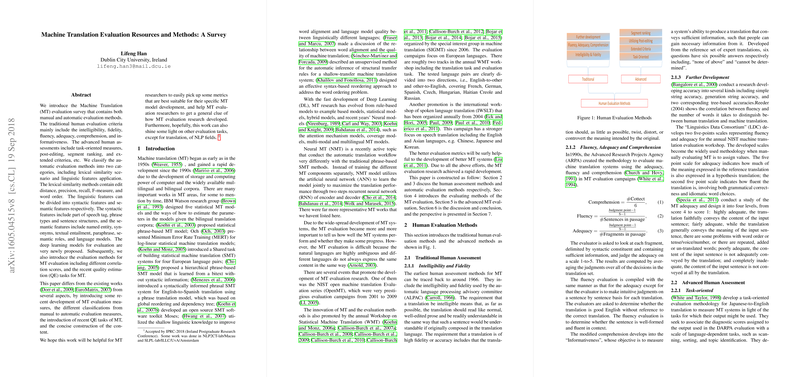The paper "Machine Translation Evaluation Resources and Methods: A Survey" offers a comprehensive overview of the various methods and resources used in evaluating machine translation (MT) systems. The survey spans both manual and automatic evaluation techniques, aimed at providing a holistic understanding to researchers and developers in the field.
Manual Evaluation Methods
Traditional human evaluation criteria are thoroughly discussed, including:
- Intelligibility: The ease with which a reader understands the translation.
- Fidelity: The accuracy with which the translation reflects the meaning of the source text.
- Fluency: The grammatical and stylistic quality of the translation.
- Adequacy: The degree to which the translation conveys the information in the source text.
- Comprehension: How well the translation is understood.
- Informativeness: The richness of the content conveyed by the translation.
Advanced human assessments go further, incorporating:
- Task-oriented measures: Performance in specific tasks using the translation.
- Post-editing: The effort required to correct the translation.
- Segment ranking: Ranking of different translation segments.
- Extended criteria: Additional qualitative assessments.
Automatic Evaluation Methods
Automatic methods are classified into two main categories: lexical similarity and linguistic features.
Lexical Similarity Scenario
- Edit Distance: Measures such as Levenshtein distance.
- Precision, Recall, and F-measure: Based on common n-grams between the translation and reference text.
- Word Order: Metrics concerned with the sequence of words.
Linguistic Features Application
- Syntactic Features:
- Part of Speech (POS) tags.
- Phrase types and sentence structures.
- Semantic Features:
- Named entities.
- Synonyms and paraphrases.
- Textual entailment.
- Semantic roles.
- LLMs.
Deep Learning Models
The paper notes that deep learning-based evaluation models are relatively new and represent an emerging area of research in MT evaluation.
MT Evaluation Methods
The survey explores different evaluation methods, including:
- Correlation Scores: Statistical measures to quantify the relationship between different evaluation metrics and human judgment.
- Quality Estimation (QE): Tasks that predict the quality of translations without reference texts, offering real-time evaluation potential.
Contributions to the Field
The paper stands out from previous works by presenting:
- Recent developments in MT evaluation metrics.
- A new classification approach from manual to automatic evaluation measures.
- An introduction to recent QE tasks in MT.
- Concise content construction for ease of understanding.
Implications
The authors hope this survey will assist MT researchers in selecting suitable evaluation metrics for their models and offer MT evaluation researchers a broad overview of the field's evolution. This survey could also inspire methodologies for evaluating other NLP tasks beyond translation.
In essence, the paper is a pivotal resource for anyone aiming to navigate the complex landscape of MT evaluation, providing both foundational knowledge and insights into the latest advancements.
